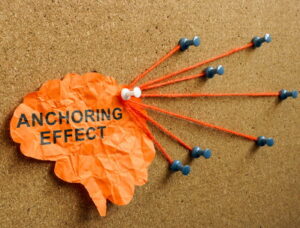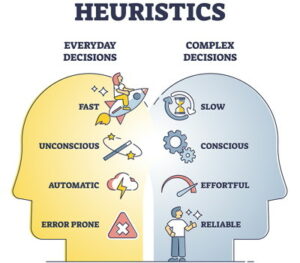 Anchoring is a cognitive bias that can have a profound influence on how people make decisions and form judgments. It refers to the tendency of individuals to rely too heavily on the first piece of information that they encounter when making decisions.
Anchoring is a cognitive bias that can have a profound influence on how people make decisions and form judgments. It refers to the tendency of individuals to rely too heavily on the first piece of information that they encounter when making decisions.
This initial piece of information, the “anchor,” then shapes the subsequent judgments and decisions made, often causing individuals to remain close to that anchor point, even if it’s arbitrary or irrelevant. Imagine being asked to decide how many African countries are in the United Nations and whether it is more or fewer than 20, as an example.
You might say it is more, but when asked to put a specific number on it will stay around and about 20, perhaps stretching to 25 or even 30. That initial figure of 20 will remain locked in your mind as a possible number of countries, in spite of the fact that it was an arbitrarily chosen one on the first place. In actual fact, the African Group is made up of the 54 African nations that are members of the UN, proving that using 20 as your anchor was misleading.
When it comes to betting, odds can become our anchor, meaning that when they drift we think we are getting good value even though we might not be.
Anchoring Decision-Making

Anchoring occurs when individuals rely too heavily on the first piece of information, the “anchor,” when making decisions or judgments. This initial anchor can be any data point, value or idea introduced at the outset of a decision-making process.
Once an anchor is set, people tend to adjust their subsequent judgments or estimates based on that anchor. They will often move closer to the anchor point when making their final decisions, even if it is arbitrary or irrelevant to the problem at hand. Anchoring is a cognitive bias that manifests in various aspects of everyday life.
In retail, for example, sellers may use a high initial price as an anchor before offering a discount, making the discounted price seem more appealing.
In negotiations, the first offer made often becomes an anchor point that influences the final agreed-upon price.
In job interviews, the first impression or initial information about a candidate can significantly influence the overall evaluation.
Anchors can be explicit or implicit. Explicit anchors are numbers or values explicitly stated, whilst implicit anchors are more subtle, like the order in which information is presented.
Anchors can also be numerical or non-numerical. For instance, describing a used car as “well-maintained by a responsible owner” can serve as a non-numerical anchor that influences the perception of its value.
People are able to adjust their anchors, but this often requires conscious effort. Adjusting anchors involves critically evaluating the relevance and accuracy of the initial information and making a conscious effort to base decisions on more rational or objective criteria. The anchoring bias can lead to suboptimal decision-making.
As an example, people may accept prices that are higher than they should be, make overly optimistic or pessimistic predictions or fail to consider a broader range of possibilities. The context in which anchoring occurs is essential.
Anchors can be particularly potent when individuals lack other relevant information to guide their decisions. They are also more likely to influence decisions when individuals are under time pressure or cognitive load. Awareness is key to combating the anchoring bias.
By recognising the presence of an anchor and consciously seeking additional information or alternative viewpoints, individuals can make more informed and rational decisions. In some cases, decision-makers may use “counter-anchors” to offset the effects of the initial anchor.
For example, in negotiations, making an initial counter-offer that is far from the anchor can reset the negotiation process. It is a way of ensuring that the initial anchor doesn’t dictate the entire negotiating procedure, bringing what you want to get out of it into sharper focus for yourself.
Anchoring Is Often Arbitrary
 The arbitrariness of anchors is a fundamental aspect of the anchoring bias. It refers to the fact that the initial anchor, which heavily influences subsequent decisions, can be entirely random, irrelevant or arbitrary in relation to the decision at hand.
The arbitrariness of anchors is a fundamental aspect of the anchoring bias. It refers to the fact that the initial anchor, which heavily influences subsequent decisions, can be entirely random, irrelevant or arbitrary in relation to the decision at hand.
An arbitrary anchor can be something entirely unrelated to the decision being made. The example given in the introduction is a good way of thinking about it, given the manner in which people are likely to stick close to the 20 African countries in the UN having been offered that as the opening gambit, even though it’s irrelevant.
Arbitrary anchors often work because they suggest a starting point for consideration. Human cognition tends to seek reference points when faced with uncertainty and even a random anchor can provide that starting point.
Arbitrary anchors have no inherent validity or logical connection to the decision variables. They are not based on facts, market conditions or any rational criteria, yet they can exert a strong influence on people’s judgments. People are often more sensitive to anchors than they realise. Even when they consciously acknowledge that an anchor is arbitrary or irrelevant, they may still find it challenging to completely disregard its influence.
One way to understand the power of arbitrary anchors is to think of them as setting the range within which subsequent judgments and decisions are made. The initial anchor can narrow the scope of possibilities in the decision-maker’s mind.
Arbitrary anchors can provide psychological comfort because they reduce the perceived complexity of a decision. They offer a starting point that simplifies the decision-making process, even if it’s based on something entirely unrelated. We see this play out all the time in retail, where an arbitrary anchor is used to set a high initial price for a product and then offering a substantial discount
This can then make the discounted figure seem like you’re getting a bargain when in actual fact it is only a bargain when compared to the initial arbitrary number chosen for the product.
Similarly, in negotiations, the first offer made by one party can become an arbitrary anchor, significantly influencing the final price that all parties are able to agree upon. This figure is often not based on research or the actual value of what is being bought, but it become key to everything that follows. In surveys, the order in which questions are asked can serve as an arbitrary anchor.
For example, if respondents are asked to estimate a high number before estimating a low number, their second estimate is likely to be higher than if they were asked the low number first. We need to make a conscious effort in order to overcome the arbitrariness of anchors. Decision-makers need to recognise when an anchor is arbitrary and question its relevance to the decision.
By actively seeking out more relevant and objective information, decision-makers can reduce the influence of arbitrary anchors. It’s essential to consider a broader range of factors when making decisions and not rely solely on the initial anchor.
The Relationship Between Anchoring & The Availability Heuristic
 The availability heuristic can contribute to anchoring. If you’ve recently encountered information related to a decision or judgment, that information can become your anchor. For example, if you’ve read or heard a lot about high real estate prices in a specific city, that information might anchor your perception of property values in that area.
The availability heuristic can contribute to anchoring. If you’ve recently encountered information related to a decision or judgment, that information can become your anchor. For example, if you’ve read or heard a lot about high real estate prices in a specific city, that information might anchor your perception of property values in that area.
On the other hand, once an anchor is set, the availability heuristic can reinforce it. If the anchor suggests a certain price for a product, and you’ve seen advertisements or heard testimonials supporting that price, the availability of this information can make the anchor seem more valid and less arbitrary.
Together, these biases can significantly impact decision-making. Information that confirms the anchor’s validity is more likely to come to mind , which is the availability heuristic at play, further reinforcing the anchor. Anchoring makes people rely heavily on initial information, whilst the availability heuristic makes them more likely to rely on easily accessible information to confirm their perception.
This combination can lead to biased decisions where people stick closely to an initial anchor and use readily available information to justify or confirm that anchor.
Recognising the presence of these biases is the first step in mitigating their effects. Being aware that anchors and easily recalled information can influence judgment can help individuals make more objective decisions.
To counter the availability heuristic, actively seek out a variety of information sources to avoid over-relying on the most accessible data can be important. When an anchor is set, consciously question its relevance and validity, especially if it seems arbitrary or unrelated to the decision. Ask yourself where the figure in question came from and whether it seems right.
Impact Of Anchoring On Odds & Probabilities
 Anchoring can significantly influence how people perceive and assess odds and probabilities, whether in sports betting, investment decisions or any situation involving uncertain outcomes. When people are presented with odds or probabilities, especially if these are the first pieces of information that they encounter, they often serve as anchors.
Anchoring can significantly influence how people perceive and assess odds and probabilities, whether in sports betting, investment decisions or any situation involving uncertain outcomes. When people are presented with odds or probabilities, especially if these are the first pieces of information that they encounter, they often serve as anchors.
For example, consider a sports bettor who initially sees that the odds of a particular team winning are 5/1. This ratio becomes the anchor for their perception of the team’s chances as well as the value of any odds moving forward.
Subsequent information, such as updated odds or additional data, is often assessed in relation to that initial anchor. People tend to make adjustments from the anchor, moving their judgments or bets closer to or farther away from that starting point. In our sports betting example, if the odds for the same team winning the game are later adjusted to 3/1, the bettor may perceive this as the team having improved chances as the odds have moved closer to the anchor, meaning that they might be more inclined to bet on them. Equally, if the odds moved to 7/ they might think they were getting better value.
Anchoring can lead to biased probability assessments. People might not assess odds or probabilities objectively based on available data; instead, they are influenced by the initial anchor.
This can result in people seeing changes in odds as significant even when they may not be, simply because the odds have shifted from the anchor point.
In sports betting and gambling, anchoring can lead to suboptimal betting decisions. If someone initially believes a team has a very low chance of winning due to a high anchor, such as odds of 20/1, they might not consider placing a bet even if the odds improve significantly, say to 5/1.
On the other hand, if someone’s anchor is set with very favourable odd, like 2/1, they may continue to bet on that outcome even if the actual chances are diminishing.
Anchors can also evoke emotional responses. If someone becomes emotionally attached to an anchor because they really want their favourite team to win, say, they may be less likely to adjust their judgments, even in the face of contradictory evidence.
The availability heuristic can also come into play when assessing odds and probabilities. If someone has recently seen or heard about a team’s performance, injuries, or winning streak, that information becomes more accessible and can affect their assessment of the team’s chances.
To make more rational betting decisions, it’s crucial for individuals to recognise the influence of anchoring and actively strive to overcome it. You can seek out additional, unbiased information about the event, for example, or consider a broader range of factors beyond just the initial odds. Setting personal limits on betting based on a rational assessment of risks and rewards rather than emotional attachment to an anchor can also help improve decision-making.
Being aware of how anchoring can influence you in your bets is key to ensure that you’re not falling foul of the problems presented by anchoring.
The likes of the Betfair Starting Price, which is seen as a more accurate sense of what a horse’s actual SP is, can be useful in avoiding the trap of anchoring. You can look to see what a horse you were going to bet on went off at on the exchange and compare it to the price offered by a bookmaker, for example, and give yourself a sense of whether or not the value on the horse was good or whether you’d fallen for the anchoring bias.
That is just one small way to ensure that you’re constantly looking our for the various cognitive biases used by bookmakers.
